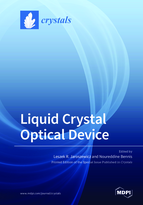Liquid Crystal Optical Device
A special issue of Crystals (ISSN 2073-4352). This special issue belongs to the section "Liquid Crystals".
Deadline for manuscript submissions: closed (10 May 2019) | Viewed by 38895
Special Issue Editors
Interests: photonics technology application for sensors devices including: hybrid liquid crystal waveguide transducers, technologies of advanced fiber optics as well as photonic crystal fiber elements
Special Issues, Collections and Topics in MDPI journals
Special Issue Information
Dear Colleagues,
Liquid crystals (LCs) are one of the key materials used in light beam manipulation, as their pronounced anisotropy and fluidity allow their refractive index to be tuned by small applied voltages. One remarkable feature of these materials is their high versatility. These materials attract scientists across disciplines such as chemistry, physics, materials science and engineering.
These kinds of materials have been used as active elements in different electro-optical devices in the visible and near IR range. By supplying a relatively low voltage, the LC molecules, individually and collectively anisotropic, are reoriented and the effective refractive index seen by an electromagnetic wave varies. This remarkable behavior spans the entire spectrum from visible to THz and microwave frequencies.
Topics of interest:
• Advances in development of new novel liquid crystalline materials and phenomena
• Biophotonic applications of liquid crystalline materials
• Emerging LCD technologies, such as polymer-stabilized blue phase liquid crystals,
• Real-time 3D holographic displays
• Holographic microscopy systems using liquid crystals
• Applications of liquid crystals in telecommunications
• Liquid crystal technology for adaptive optics
• Active meta-materials and meta-surfaces
• Recent advances in nematic liquid crystal nonlinear optics
• Thermography using liquid crystals
• Photoresponsive and photoalignable materials
Prof. Leszek R. Jaroszewicz
Dr. Noureddine Bennis
Guest Editors
Manuscript Submission Information
Manuscripts should be submitted online at www.mdpi.com by registering and logging in to this website. Once you are registered, click here to go to the submission form. Manuscripts can be submitted until the deadline. All submissions that pass pre-check are peer-reviewed. Accepted papers will be published continuously in the journal (as soon as accepted) and will be listed together on the special issue website. Research articles, review articles as well as short communications are invited. For planned papers, a title and short abstract (about 100 words) can be sent to the Editorial Office for announcement on this website.
Submitted manuscripts should not have been published previously, nor be under consideration for publication elsewhere (except conference proceedings papers). All manuscripts are thoroughly refereed through a single-blind peer-review process. A guide for authors and other relevant information for submission of manuscripts is available on the Instructions for Authors page. Crystals is an international peer-reviewed open access monthly journal published by MDPI.
Please visit the Instructions for Authors page before submitting a manuscript. The Article Processing Charge (APC) for publication in this open access journal is 2600 CHF (Swiss Francs). Submitted papers should be well formatted and use good English. Authors may use MDPI's English editing service prior to publication or during author revisions.
Keywords
- Liquid crystal devices
- Holography
- Microscopy
- Wave-front sensing
- Active meta-materials
- Nonlinear optics







